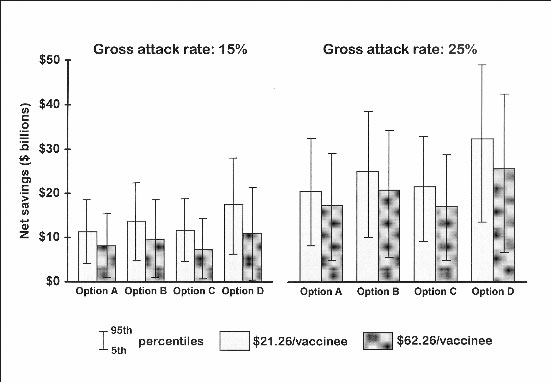Volume 5, Number 5—October 1999
Research
The Economic Impact of Pandemic Influenza in the United States: Priorities for Intervention
Figure 3

Figure 3. Four options for responding to an influenza pandemic: mean net economic returns. Notes: a) Bars show mean net returns for each option and assumed cost of vaccination. b) Option A: Similar to current Advisory Committee on Immunization Practices recommendations, with production and use similar to current, intra-pandemic recommendations (17). Assumed approximately 77 million vaccinees. Option B: Number of vaccinees as outlined in Scenario A plus 20 million essential service providers (5 million health-care workers + 15 million other service providers). Option C: Aim to achieve a 40% coverage of total U.S. population. Option D: Aim to achieve 60% coverage of total U.S. population (Appendix 2).
References
- Patriarca PA, Cox NJ. Influenza pandemic preparedness plan for the United States. J Infect Dis. 1997;176(Suppl 1):S4–7. DOIPubMedGoogle Scholar
- Simonsen L, Clarke MJ, Schonberger LB, Arden NH, Cox NJ, Fukuda K. Pandemic versus epidemic influenza mortality: a pattern of changing age distribution. J Infect Dis. 1998;178:53–60.PubMedGoogle Scholar
- Office of Technology Assessment. U.S. Congress. Cost effectiveness of influenza vaccination. Washington: Government Printing Office; 1981.
- Kavet J. A perspective on the significance of pandemic influenza. Am J Public Health. 1977;67:1063–70. DOIPubMedGoogle Scholar
- Campbell DS, Rumley MA. Cost-effectiveness of the influenza vaccine in a healthy, working-age population. J Occup Environ Med. 1997;39:408–14. DOIPubMedGoogle Scholar
- Carrat F, Valleron A-J. Influenza mortality among the elderly in France, 1980-90: how many deaths may have been avoided through vaccination? J Epidemiol Community Health. 1995;49:419–25. DOIPubMedGoogle Scholar
- Riddiough MA, Sisk JE, Bell JC. Influenza vaccination: cost-effectiveness and public policy. JAMA. 1983;249:3189–95. DOIPubMedGoogle Scholar
- Patriarca PA, Arden NH, Koplan JP, Goodman RA. Prevention and control of type A influenza infections in nursing homes: benefits and costs of four approaches using vaccination and amantadine. Ann Intern Med. 1987;107:732–40.PubMedGoogle Scholar
- Schoenbaum SC. Economic impact of influenza: the individuals perspective. Am J Med. 1987;82(Supp 6A):26–30. DOIPubMedGoogle Scholar
- Jefferson T, Demicheli V. Socioeconomics of influenza. In: Nicholson KG, Webster RG, Hay AJ, editors. Textbook of influenza. London (UK): Blackwell Science; 1998. p. 541-7.
- Schoenbaum SC, McNeil BJ, Kavet J. The swine-influenza decision. N Engl J Med. 1976;295:759–65.PubMedGoogle Scholar
- Cliff AD, Haggett P. Statistical modelling of measles and influenza outbreaks. Stat Methods Med Res. 1993;2:43–73. DOIPubMedGoogle Scholar
- Critchfield GC, Willard KE. Probabilistic analysis of decision trees using Monte Carlo simulation. Med Decis Making. 1986;6:85–92. DOIPubMedGoogle Scholar
- Dobilet P, Begg CB, Weinstein MC, Braun P, McNeil BJ. Probabilistic sensitivity analysis using Monte Carlo simulation: a practical approach. Med Decis Making. 1985;5:157–77. DOIPubMedGoogle Scholar
- Dittus RS, Roberts SD, Wilson JR. Quantifying uncertainty in medical decisions. J Am Coll Cardiol. 1989;14:23A–8.PubMedGoogle Scholar
- U.S. Bureau of the Census. Statistical abstract of the United States: 1997. 117th ed. Washington: The Bureau; 1997.
- Centers for Disease Control and Prevention. Prevention and control of influenza: recommendations of the Advisory Committee on Immunization Practices (ACIP). MMWR Morb Mortal Wkly Rep. 1998;47(RR-6):1–26.PubMedGoogle Scholar
- Evans M, Hastings N, Peacock B. Statistical distributions. 2nd ed. New York: John Wiley; 1993.
- Glezen PW. Emerging infections: pandemic influenza. Epidemiol Rev. 1996;18:64–76.PubMedGoogle Scholar
- Mullooly JP, Barker WH. Impact of type A influenza on children: a retrospective study. Am J Public Health. 1982;72:1008–16. DOIPubMedGoogle Scholar
- Barker WH, Mullooly JP. Impact of epidemic type A influenza in a defined adult population. Am J Epidemiol. 1980;112:798–813.PubMedGoogle Scholar
- Simonsen L, Clarke MJ, Williamson GD, Stroup DF, Arden NH, Schonberger LB. The impact of influenza epidemics on mortality: introducing a severity index. Am J Public Health. 1997;87:1944–50. DOIPubMedGoogle Scholar
- Fox JP, Hall CE, Cooney MK, Foy HM. Influenzavirus infections in Seattle families, 1975-1979. I. Study design, methods and the occurrence of infections by time and age. Am J Epidemiol. 1982;116:212–27.PubMedGoogle Scholar
- Glezen WP, Decker M, Joseph SW, Mercready RG. Acute respiratory disease associated with influenza epidemics in Houston, 1981-1983. J Infect Dis. 1987;155:1119–26.PubMedGoogle Scholar
- Serfling RE. Sherman Il, Houseworth WJ. Excess pneumonia-influenza mortality by age and sex in three major influenza A2 epidemics, United States, 1957-58, 1960 and 1963. Am J Epidemiol. 1967;86:433–41.PubMedGoogle Scholar
- Barker WH, Mullooly JP. Pneumonia and influenza deaths during epidemics: implications for prevention. Arch Intern Med. 1982;142:85–9. DOIPubMedGoogle Scholar
- Glezen WP, Payne AA, Snyder DN, Downs TD. Mortality and influenza. J Infect Dis. 1982;146:313–21.PubMedGoogle Scholar
- McBean AM, Babish JD, Warren JL. The impact and cost of influenza in the elderly. Arch Intern Med. 1993;153:2105–11. DOIPubMedGoogle Scholar
- Barker WH. Excess pneumonia and influenza associated hospitalization during influenza epidemics in the United States, 1970-78. Am J Public Health. 1986;76:761–5. DOIPubMedGoogle Scholar
- Haddix AC, Teutsch SM, Shaffer PA, Dunet DO. Prevention effectiveness. New York: Oxford University Press; 1996.
- Fed Regist. 1996;61:46301–2.
- Kaufmann AF, Meltzer MI, Schmid GP. The economic impact of a bioterrorist attack: are prevention and postattack intervention programs justifiable? Emerg Infect Dis. 1997;3:83–94. DOIPubMedGoogle Scholar
- Robinson LJ, Barry PJ. The competitive firm's response to risk. New York: Macmillian; 1987.
- Neustadt RE, Fineberg HV. The swine flu affair: decision making on a slippery disease. Washington: U.S. Department of Health Education, and Welfare; 1978.
Page created: December 15, 2010
Page updated: December 15, 2010
Page reviewed: December 15, 2010
The conclusions, findings, and opinions expressed by authors contributing to this journal do not necessarily reflect the official position of the U.S. Department of Health and Human Services, the Public Health Service, the Centers for Disease Control and Prevention, or the authors' affiliated institutions. Use of trade names is for identification only and does not imply endorsement by any of the groups named above.